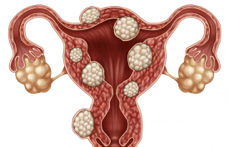
Uterine Fibroids: Everything you need to know..
What are fibroids?
Uterine fibroids are noncancerous growths of the uterus that often appear during childbearing years. Also called leiomyomas or myomas, uterine fibroids aren't associated with an increased risk of uterine cancer and almost never develop into cancer. According to the National Institutes of Health (NIH), about up to 80 percent of women have them by the age of 50.
Fibroids range in size from seedlings, undetectable by the human eye, to bulky masses that can distort and enlarge the uterus. You can have a single fibroid or multiple ones. In extreme cases, multiple fibroids can expand the uterus so much that it reaches the rib cage and can add weight.
Fibroids are generally classified by their location. Intramural fibroids are the most common type of fibroid, appear within the muscular wall of the uterus, grow larger and can stretch your womb. Submucosal fibroids develop in the middle muscle layer, or myometrium, of your uterus. Subserosal fibroids project to the outside of the uterus, may grow large enough to make your womb appear bigger on one side. Pedunculated fibroids, Subserosal tumors can develop a stem, a slender base that supports the tumor. When they do, they’re known as pedunculated fibroids.

Symptoms:
Most women don’t have any symptoms and may never know they have fibroids. Around 1 in 3 women with fibroids will experience symptoms.
In those that do, symptoms can be influenced by the location, size and number of fibroids.
In women who have symptoms, the most common signs and symptoms of uterine fibroids include: heavy menstrual bleeding, menstrual periods lasting more than a week, increased menstrual cramping, pelvic pressure or pain, frequent urination, difficulty emptying the bladder, pain during intercourse, constipation and backache or leg pains.
Fibroids may shrink during and after menopause. This is because women undergoing menopause are experiencing a drop in their levels of estrogen and progesterone, hormones that stimulate fibroid growth.
Causes:
It remains unclear exactly what causes fibroids. They may be related to estrogen levels. During the reproductive years, estrogen and progesterone levels are higher. When estrogen levels are high, especially during pregnancy, fibroids tend to swell. They are also more likely to develop when a woman is taking birth control pills that contain estrogen.
Low estrogen levels can cause fibroids may shrink, such during and after menopause.
Research and clinical experience point to these factors:
Genetic changes.
Hormones.
Other growth factors.
Doctors believe that uterine fibroids develop from a stem cell in the smooth muscular tissue of the uterus (myometrium). A single cell divides repeatedly, eventually creating a firm, rubbery mass distinct from nearby tissue.
The growth patterns of uterine fibroids vary — they may grow slowly or rapidly, or they may remain the same size. Some fibroids go through growth spurts, and some may shrink on their own.
Risk factors:
Factors that can have an impact on fibroid development include:
Race. Black women are more likely to have fibroids than are women of other racial groups.
Heredity. If your mother or sister had fibroids, you're at increased risk of developing them.
Other factors. Onset of menstruation at an early age; obesity; a vitamin D deficiency; having a diet higher in red meat and lower in green vegetables, fruit and dairy; and drinking alcohol, appear to increase your risk of developing fibroids.
Complications:
Fibroids do not normally result in complications, but if they occur, they can be serious and even life-threatening.
Complications may include:
Menorrhagia, also called heavy periods.
Abdominal pain.
Drop in red blood cells (anemia).
Pregnancy problems: Preterm birth, labor problems and miscarriages.
Infertility: In some cases, fibroids can make it harder for the fertilized egg to attach itself to the lining of the womb. A submucosal fibroid growing on the inside of the uterine cavity may change the shape of the womb, making conception more difficult.
Pregnancy and fibroids
Fibroids usually don't interfere with getting pregnant. However, it's possible that fibroids — especially submucosal fibroids — could cause infertility or pregnancy loss.
Fibroids may also raise the risk of certain pregnancy complications, such as placental abruption, fetal growth restriction and preterm delivery.
When to see a doctor:
See your doctor if you have:
Pelvic pain that doesn't go away
Overly heavy, prolonged or painful periods
Spotting or bleeding between periods
Difficulty emptying your bladder
Unexplained low red blood cell count (anemia)
How are fibroids diagnosed?
For a proper diagnosis, you’ll need to see a gynecologist to get a pelvic exam. This exam is used to check the condition, size, and shape of your uterus. You may also need other tests, which include:
Ultrasound, Pelvic MRI, Saline Sonohysteragram or Hysteroscopy.
References:
1- https://www.mayoclinic.org/diseases-conditions/uterine-fibroids/symptoms-causes/syc-20354288
2- https://www.healthline.com/health/uterine-fibroids
3- https://www.medicalnewstoday.com/articles/151405.php#types-of-fibroid